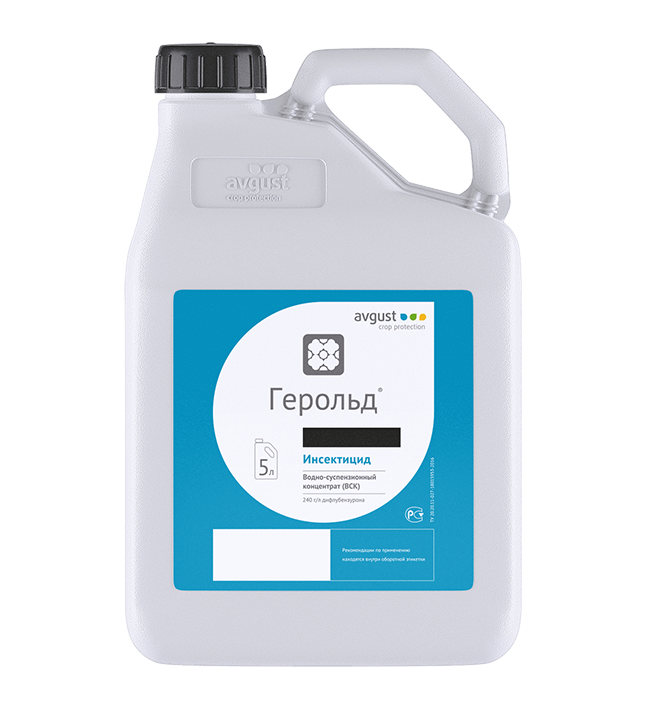
GEROLD
diflubenzuron, 240 g/l

diflubenzuron, 240 g/l
Advantages of the drug:
• highly effective against lepidopteran pests, including cabbage moths
• unique chemical class and specific mechanism of action
• destruction of pest populations resistant to pyrethroids and FOS
• long residual effect – pest control during uneven flight and larval hatching
• moderate negative impact on beneficial insects, predatory mites and bees
• possibility of aviation use against locusts
Preparative form:
water-suspension concentrate.
Mechanism of action:
Herold® has a contact and intestinal effect, disrupts molting processes in harmful insects. It fundamentally differs in its action from organophosphorus and pyrethroid drugs.
The drug has no effect on adults, but disrupts the development of eggs and larvae (ovicidal and larvicidal effects).
The ovicidal effect occurs when females lay eggs on treated plants.
Impact speed:
The death of pest larvae is observed approximately 10 days after spraying, but after 3 – 5 days they begin to move less and sharply reduce food consumption.
Period of protective action:
Herold® remains active for 25 – 30 days after spraying.
Recommendations for use:
Treatment against locusts is carried out once during the period of mass hatching and development of larvae (necessarily before the locusts fledgling!). If a lot of winged locusts have already appeared in the population, it is better to use Herold® in a mixture with any fast-acting insecticide that is effective against adults.
Rapeseed against cabbage moths is treated once during the period when younger caterpillars appear.
Cabbage against a complex of lepidopteran pests, as well as corn, sunflower and soybeans against cotton bollworms, are treated once during the hatching period of younger caterpillars.
Gardens are treated against codling moths and leaf miners at the beginning of egg laying of pests, and against leaf-eating lepidoptera – when younger caterpillars appear.
To combat the codling moth, one spray is enough for early varieties, and two for later varieties.
The waiting period for apple trees is 40 days, for cabbage – 30 days, for field crops – 20 days, and in areas inhabited by locusts – not established. It is recommended to add an adjuvant (for example, Allure® or Polyphem®) to the working solution of the insecticide.
| Culture, object | Pest | Consumption rate of the drug, l/ha |
| Apple tree | codling moth | 1-2 |
| Apple tree | Ringed silkworm, goldentail, hawthorn | 0.2 |
| Cabbage | Cabbage cutworm, white moth, cabbage moth | 0.15 |
| Corn, sunflower, soybeans | Cotton bollworm | 0.5-1 |
| Rape | Cabbage moth | 0.5-1 |
| Pastures, meadows, areas infested with locusts | Locusts | 0.05 |
|
Pastures, meadows, areas infested with locusts, wild vegetation |
Locusts | 0.05 |
Possibility of resistance:
no cross-resistance to diflubenzuron was observed.
It is recommended to use the drug to control pests whose populations have developed resistance to pyrethroids.
and FOS insecticides.
Restrictions:
the drug is low-hazard for bees (hazard class 3). But you should still follow the following instructions: be sure to notify beekeepers of apiaries about the nature, timing and areas of processing 4 – 5 days in advance; carry out treatment in the morning or evening at a wind speed of no more than 4 – 5 m/s; maintain a border protection zone for bees of at least 2 – 3 km; Possibility of resistance:
no cross-resistance to diflubenzuron was observed.
It is recommended to use the drug to control pests whose populations have developed resistance to pyrethroids.
and FOS insecticides.
Restrictions:
the drug is low-hazard for bees (hazard class 3). But you should still follow the following instructions: be sure to notify beekeepers of apiaries about the nature, timing and areas of processing 4 – 5 days in advance; carry out treatment in the morning or evening at a wind speed of no more than 4 – 5 m/s; maintain a border protection zone for bees of at least 2 – 3 km; ensure that the flight of bees is limited to at least 36 – 48 hours.
Compatibility:
compatible with most insecticides and fungicides, with the exception of highly alkaline preparations.
Working fluid consumption:
on field crops and areas inhabited by locusts – 200 – 400 l/ha, in gardens – 600 – 1200 l/ha; for aerial treatment – 25 – 50 l/ha.
Package:
canisters of 5 and 10 l.